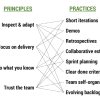Business Transformation Requires Transformational Leaders
Leadership and teaming skills are front and center in times of rapid change. Meet today’s constant disruption head on with expert guidance in leadership, business strategy, transformation, and innovation. Whether the disruption du jour is a digitally-driven upending of traditional business models, the pandemic-driven end to business as usual, or the change-driven challenge of staffing that meets your transformation plans—you’ll be prepared with cutting edge techniques and expert knowledge that enable strategic leadership.
Recently Published
Agile Maturation Requires More Than Just Physical Changes
People in every organization that has Agile teams reach the point where they ask themselves: how far do we go with Agile? As we explore in this Executive Update, the answer depends on the strength of the Agile principles — not just in the teams — but in the larger organization.
It truly takes a village to build a nimble (Lean) and flexible (Agile) enterprise architecture (EA) program in this digital era. EA as a discipline may not have to change drastically to address digital transformation, but EA does have to play a much bigger role in embracing the change swiftly and facilitating the change across the enterprise.
Those of us born before 1990 know how much the world has changed in only a few years. Among a myriad of changes, we have seen obsolete technologies mercilessly replaced and witnessed a couple of global economic collapses, and several products and services that we could never have imagined before — like the Internet — have become part of our daily lives. Whenever I see new, life-changing technology, I can’t help thinking: how did we get here so fast?
One of the hardest things to teach or learn is self-awareness. By self-awareness, I mean the capacity to evaluate oneself accurately from the perspective of others and the ability to detect differences between our behavior and our values. So many leaders are unaware of what others around them truly think about them and at some point in these leaders’ careers, this inevitably leads to trouble. Usually these troubled leaders are constantly interpreting the world around them into their internal logic, thus preventing them from seeing the gap between their own internal understanding of themselves and what others think.
While the rise of financial technology companies and services has been gradual and steady over the years, beginning perhaps with the founding of PayPal in 1998, there’s been a particularly explosive boom in this sector just in the past couple years, with a new FinTech startup sprouting up nearly every week and disrupting the financial game in a major way. Indeed, companies like Stripe, Intuit’s Mint, Payoneer, and even such developments as Apple Pay are offering an array of fundamental changes in the many ways consumers and small businesses interact with their finances.
A frequent complaint we hear from Agile teams is that their self-organization is not respected and their manager routinely overrules their decisions. If you talk to the manager, he or she complains that the team doesn’t respect company policies anymore and makes decisions they’re not entitled to make. What seems to be a battle about power in many cases and like a confusion of self-organization with autonomy turns out to be an unfinished Agile integration into the organization.
A Mandate for a Meta-Architect
In a recent Advisor, we called out an important function of architects: “to grapple with the elements of the enterprise that are disproportionate in their influence, and make them deliver [business value].” What is implicit in that statement is a recognition that “grappling” occurs because complex situations demand that we make the right tradeoffs and choices. It’s all about decisions. Who makes these decisions?
The truly game-changing opportunities or challenges we face in our businesses are a blend of the complicated and the complex. Being able to understand the difference between the two domains and manage accordingly is thus the key to success. An inability to differentiate between complicated and complex leads to one of the most fundamental causes of business and technology failure — the illusion of control.

















